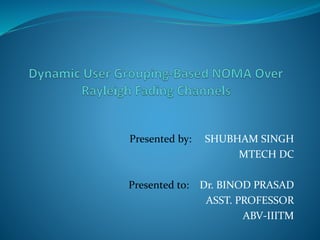
Dynamic user grouping based NOMA
- 1. Presented by: SHUBHAM SINGH MTECH DC Presented to: Dr. BINOD PRASAD ASST. PROFESSOR ABV-IIITM
- 2. NOMA Non-orthogonal multiple access(NOMA) considered as potential key technology for the fifth generation mobile communications. In OMA, only one user can be assigned a single radio resource, such as frequency division or time division, while NOMA can allocate one resource to multiple users. Compared to orthogonal transmission, NOMA improves receiver complexity in exchange for higher spectral efficiency.
- 3. Types of NOMA NOMA is divided into two types, one is the power domain NOMA(PD-NOMA), and the other is the code domain NOMA. The most typical one in the code domain NOMA is NOMA- 2000. Since the research on NOMA has started from year 2000, it is called NOMA-2000
- 4. NOMA-2000 A. Maatouk et al. used orthogonal frequency division multiple access (OFDMA) signal waveform and MC-CDMA signal waveform to combine in NOMA-2000. At the receiving end, NOMA-2000 detects two sets of orthogonal signals by iterative interference cancellation .
- 5. PD-NOMA The basic idea of the PD-NOMA is to use the non- orthogonal transmission of the user's transmit power at the transmitting end, introduce interference, and pass the SIC receiver at the receiving end to eliminate interference and implement quadrature demodulation. The sub-channel transmission of PD-NOMA still adopts orthogonal frequency division multiplexing.
- 6. PD-NOMA The sub-channels are orthogonal and do not interfere with each other, but one sub-channel is no longer only allocated to one user, but shared by multiple users. At the transmitting end, different users on the same sub- channel are transmitted by using power multiplexing technology. The signal power of each user arriving at the receiving end is different.
- 7. User Grouping If users are grouped by a suitable method, the accuracy of the system detection at the receiving end can be greatly improved. The system error rate can be reduced.
- 8. Principle Of NOMA-2000 uses two sets of orthogonal signal waveforms. the first set of orthogonal signal waveform used CDMA and the other set used TDMA. CDMA is for the first N users in N subcarriers and they augment it with TDMA when the number of users exceeds the number of subcarriers N.
- 9. Principle Of NOMA-2000 We use OFDMA for the first N users and use MC-CDMA for the rest M users. Within the OFDMA signal, there is no interference between users, as is the case in orthogonal MC-CDMA. However, there is a strong interference between OFDMA users and MC-CDMA users. NOMA-2000 solves the problem of inter-user interference by adopting iterative interference cancellation at the receiver.
- 10. Spread spectrum technology Spread spectrum technology is defined as a radio frequency communication system that spreads a baseband signal into a wider frequency band by injecting a higher frequency signal. The energy of the transmitted signal is spread into a wider frequency band, making it look like noise. Spread spectrum technology simply introducing a corresponding spreading code somewhere and spreads the information into a wider frequency band.
- 11. Despreading The spreading code is removed prior to data recovery in the receive link, known as dispreading. Despreading reconstructs information on the original bandwidth of the signal. The spreading code needs to be known in advance at both ends of the information transmission path. The direct result of spreading is to occupy a wider frequency band, thus wasting limited frequency resources.
- 13. Detection Methods Two different detection methods that are hard decision and soft decision. The hard decision is to simply judge the output signal by setting the threshold. The value which is above the threshold is considered to be 1, and the value below the threshold is considered to be 0. The soft decision is to first quantize the decision input into some values, and calculate the most likely original value of each value by the maximum posterior probability.
- 14. Principle of PD-NOMA Different with NOMA-2000, power-domain NOMA superposes MC-CDMA signal on OFDMA signal directly without spreading spectrum. Compared with OMA, PD-NOMA promises a significant channel capacity gain because it allows more users use the same spectrum at the same time. Problem with PD-NOMA is that it will make users have unequal quality of service (QoS).
- 15. Rayleigh fading channel The Rayleigh fading channel is a statistical model of the radio signal propagation environment. In the wireless communication channel environment, the strength of the total signal obeys the Rayleigh distribution. Due to the movement of the receiver and other reasons, the characteristics of signal strength and phase are fluctuating, which is called Rayleigh fading channel. It is suitable for describing wireless channels in densely populated urban centers.
- 16. SIMULATION RESULTS •We use average bit error rate (BER) to evaluate the performance of communication system.
- 17. Comparison of PD-NOMA and NOMA-2000 using Ber v/s SNR curve
- 18. Conclusion Comparing the NOMA-2000 with the PD-NOMA, we nd that the PD-NOMA showed better performance than the NOMA-2000 under different channel overload conditions.
- 19. References A. Maatouk, E. Çal³kan, M. Koca, M. Assaad, G. Gui, and H. Sari, ``Frequency-domain NOMA with two sets of orthogonal signal waveforms,'' IEEE Commun. Lett., vol. 22, no. 5, pp. 906909, May 2018. J.-M. Kang and I.-M. Kim, ``Optimal user grouping for downlink NOMA,'' IEEE Wireless Commun. Lett., vol. 7, no. 5, pp. 724727, Oct. 2018. K. Janghel and S. Prakriya, ``Performance of adaptive OMA/cooperative- NOMA scheme with user selection,'' IEEE Commun. Lett., vol. 22, no. 10, pp. 20922095, Oct. 2018.